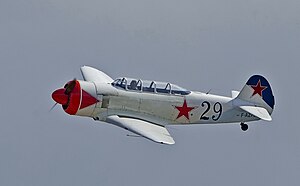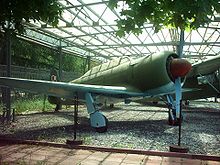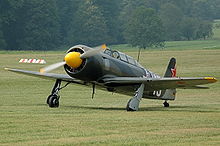Yakovlev Yak-11
| Yak-11 | |
|---|---|

| |
| Let C-11 | |
| Role | Training aircraft |
| Manufacturer | Yakovlev, Let |
| First flight | 10 November 1945 |
| Introduction | 1946 |
| Retired | 1962 |
| Primary user | Soviet Air Force |
| Number built | 4,566 |
The Yakovlev Yak-11 (Russian: Яковлев Як-11; NATO reporting name: "Moose") is a trainer aircraft used by the Soviet Air Force and other Soviet-influenced air forces from 1947 until 1962.
History[]
The Yakovlev design bureau began work on an advanced trainer based on the Yak-3 fighter in mid-1944, although the trainer was of low priority owing to the ongoing Second World War.[1] The first prototype of the new trainer, designated Yak-UTI or Yak-3UTI flew in late 1945. It was based on the radial-powered Yak-3U, but with the new Shvetsov ASh-21 seven-cylinder radial replacing the ASh-82 of the Yak-3U.[2][nb 1] It used the same all-metal wings as the Yak-3U, with a fuselage of mixed metal and wood construction. The pilot and observer sat in tandem under a long canopy with separate sliding hoods. A single synchronised UBS 12.7 mm machine gun and wing racks for two 100 kg (220 lb) bombs comprised the aircraft's armament.[3]

An improved prototype flew in 1946, with revised cockpits and a modified engine installation with the engine mounted on shock absorbing mounts.[2] This aircraft passed state testing in October 1946, with production beginning at factories in Saratov and Leningrad in 1947.[4]
Production Yak-11s were heavier than the prototypes, with later batches fitted with non-retractable tailwheels and revised propellers. A 7.62 mm ShKAS machine gun was sometimes fitted instead of the UBS, while some were fitted with rear-view periscopes above the windscreen.[4] Soviet production totalled 3,859 aircraft between 1947 and 1955. with a further 707 licence-built by Let in Czechoslovakia as the C-11.[5]
The Yak-11 set five world-class records.
Yak-11U[]
In 1951, Yakovlev revised the design of the Yak-11, adding a retractable tricycle landing gear, with two variants proposed, the Yak-11U basic trainer and Yak-11T proficiency trainer, which carried similar equipment to contemporary jet fighters. The new aircraft had reduced fuel capacity and was unsuitable for operations on rough or snow-covered runways, and so was rejected for Soviet service, although a few examples were built in Czechoslovakia as the C-11U.[6]
Operational history[]

The Yak-11 entered service in 1947, serving as a standard advanced trainer with the Soviet Air Forces and DOSAAF.[7] Both the Yak-11 and C-11 were used in all Warsaw Pact countries and were exported to eighteen countries, including many African, Middle Eastern and Asian countries.[4]
North Korean Yak-11s were used in combat in the Korean War, with one Yak-11 being the first North Korean aircraft shot down by US forces when it was destroyed by a North American F-82 Twin Mustang over Kimpo Airfield on 27 June 1950.[8] East Germany used the Yak-11 to intercept American reconnaissance balloons.[7]
Survivors[]

Due to its Yak-3 lineage, the Yak-11 has recently seen widespread popularity among warbird enthusiasts. Highly modified versions of the Yak-11 are often seen at air races. About 120 Yak-11s remain airworthy.
Operators[]




- Royal Afghan Air Force received 14 aircraft from 1958. None remain in service since 1999.
- Albanian Air Force received four aircraft.
- North Korean Air Force
- Polish Air Force used 101 Soviet Yak-11s and 37 Czech-built C-11s
- Somali Air Corps – Retired
- Soviet Air Force
- DOSAAF
- Yemen Air Force
Specifications (Yak-11)[]

General characteristics
- Crew: two, student and instructor
- Length: 8.20 m (26 ft 10.5 in)
- Wingspan: 9.4 m (30 ft 10 in)
- Height: 3.28 m (10 ft 5 in)
- Wing area: 15.40 m2 (166 sq ft)
- Empty weight: 1,900 kg (4,189 lb)
- Max takeoff weight: 2,440 kg (5,379 lb)
- Powerplant: 1 × Shvetsov ASh-21 air-cooled radial piston engine, 521 kW (700 hp)
Performance
- Maximum speed: 460 km/h (289 mph, 248 kn)
- Cruise speed: 370 km/h (230 mph, 200 kn)
- Range: 1,250 km (795 mi, 691 nmi)
- Service ceiling: 7,100 m (23,295 ft)
- Rate of climb: 8.1 m/s (1,600 ft/min)
- Wing loading: 161 kg/m2 (32.9 lb/sq ft)
- Power/mass: 0.17 kW/kg (0.10 hp/lb)
Armament
- 1x nose-mounted machine gun, either 12.7 mm UBS or 7.62 mm ShKAS
- up to 200 kg (440 lb) of bombs on two underwing racks
See also[]
Related development
Aircraft of comparable role, configuration, and era
Notes[]
Citations[]
- ^ a b Gunston 1995, p. 469.
- ^ a b Gordon Komissarov and Komissarov 2005, p. 249.
- ^ Gunston and Gordon 1997, p. 97.
- ^ a b c Gunston and Gordon 1997, p. 99.
- ^ Gordon Komissarov and Komissarov 2005, pp. 250–251.
- ^ Gordon Komissarov and Komissarov 2005, p. 251.
- ^ a b Gordon Komissarov and Komissarov 2005, p. 250.
- ^ Thompson 2001, pp. 160–161.
References[]
| Wikimedia Commons has media related to Yakovlev Yak-11. |
- Gordon, Yefim, Dmitry Komissarov and Sergey Komissarov. OKB Yakovlev: A History of the Design Bureau and its Aircraft. Hinkley, UK: Midland Publishing, 2005. ISBN 1-85780-203-9.
- Gunston, Bill. The Osprey Encyclopedia of Russian Aircraft 1975–1995. London, UK: Osprey, 1995. ISBN 1-85532-405-9.
- Gunston, Bill and Yefim Gordon. Yakovlev Aircraft since 1924. London, UK: Putnam Aeronautical Books, 1997. ISBN 1-55750-978-6.
- Thompson, Warren. "Twin Mustang in Korea". International Air Power Review. Volume 3, Winter 2001/2002. Norwalk, Connecticut, USA:AIRtime Publishing. ISBN 1-880588-36-6. ISSN 1473-9917. pp. 156–167.
- Yakovlev aircraft
- Low-wing aircraft
- 1940s Soviet military trainer aircraft
- Aerobatic aircraft
- Single-engined tractor aircraft
- Aircraft first flown in 1945